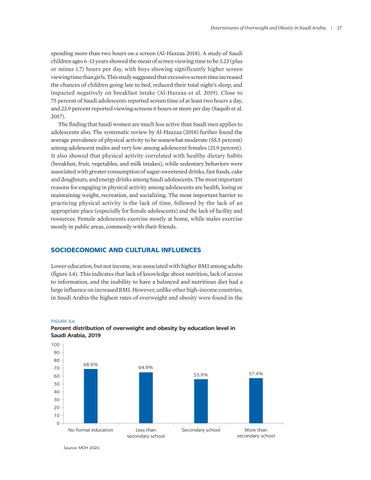Determinants of Overweight and Obesity in Saudi Arabia
spending more than two hours on a screen (Al-Hazzaa 2018). A study of Saudi children ages 6–13 years showed the mean of screen viewing time to be 3.23 (plus or minus 1.7) hours per day, with boys showing significantly higher screen viewing time than girls. This study suggested that excessive screen time increased the chances of children going late to bed, reduced their total night’s sleep, and impacted negatively on breakfast intake (Al-Hazzaa et al. 2019). Close to 75 percent of Saudi adolescents reported screen time of at least two hours a day, and 23.9 percent reported viewing screens 6 hours or more per day (Saquib et al. 2017). The finding that Saudi women are much less active than Saudi men applies to adolescents also. The systematic review by Al-Hazzaa (2018) further found the average prevalence of physical activity to be somewhat moderate (55.5 percent) among adolescent males and very low among adolescent females (21.9 percent). It also showed that physical activity correlated with healthy dietary habits (breakfast, fruit, vegetables, and milk intakes), while sedentary behaviors were associated with greater consumption of sugar-sweetened drinks, fast foods, cake and doughnuts, and energy drinks among Saudi adolescents. The most important reasons for engaging in physical activity among adolescents are health, losing or maintaining weight, recreation, and socializing. The most important barrier to practicing physical activity is the lack of time, followed by the lack of an appropriate place (especially for female adolescents) and the lack of facility and resources. Female adolescents exercise mostly at home, while males exercise mostly in public areas, commonly with their friends.
SOCIOECONOMIC AND CULTURAL INFLUENCES Lower education, but not income, was associated with higher BMI among adults (figure 3.4). This indicates that lack of knowledge about nutrition, lack of access to information, and the inability to have a balanced and nutritious diet had a large influence on increased BMI. However, unlike other high-income countries, in Saudi Arabia the highest rates of overweight and obesity were found in the
FIGURE 3.4
Percent distribution of overweight and obesity by education level in Saudi Arabia, 2019 100 90 80 70
68.9%
64.9%
60
55.9%
57.4%
Secondary school
More than secondary school
50 40 30 20 10 0 No formal education
Source: MOH 2020.
Less than secondary school
|
27






